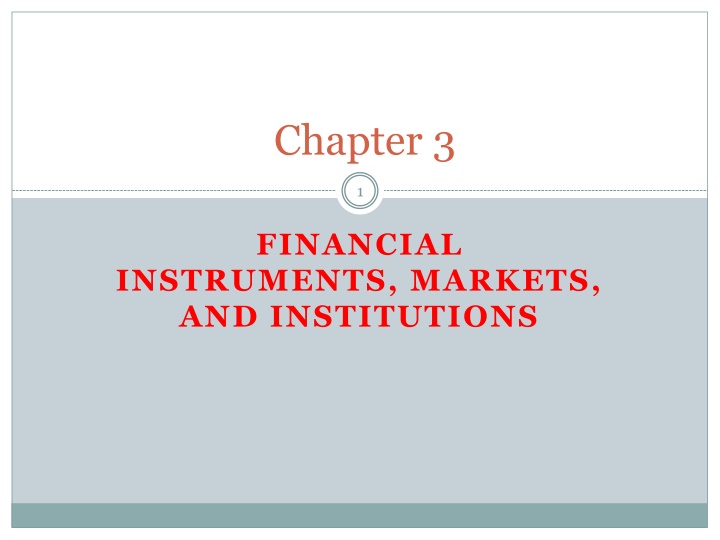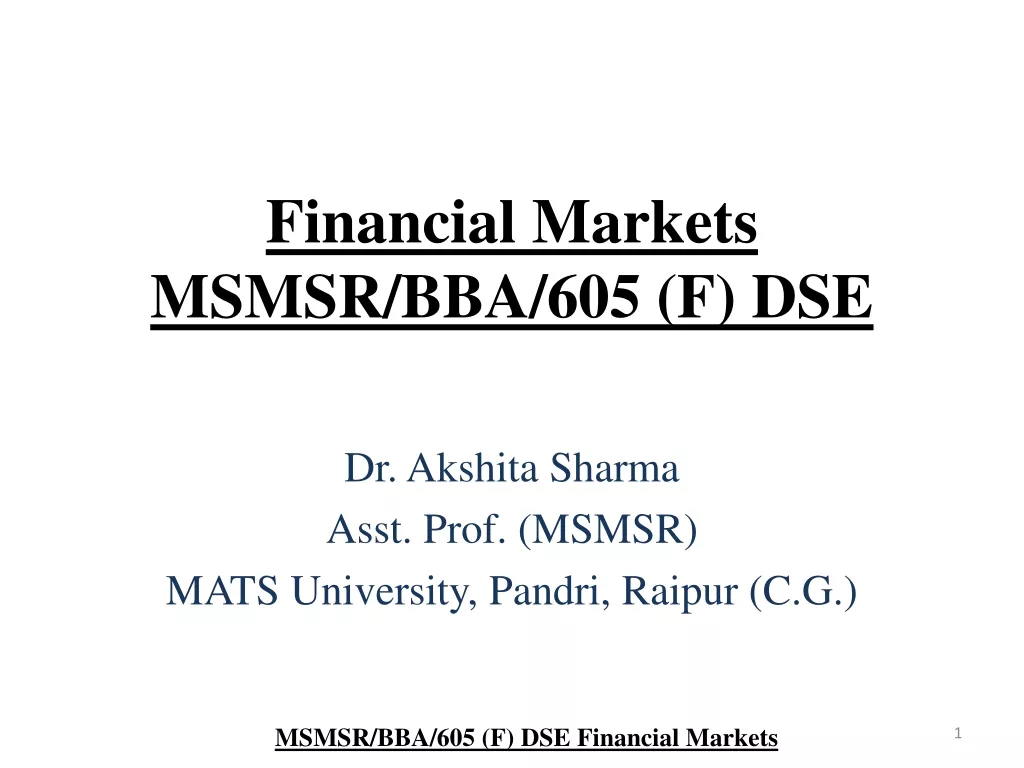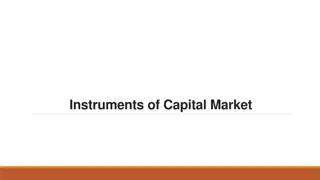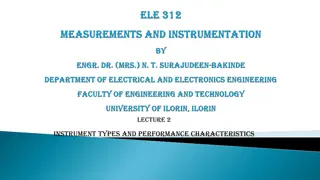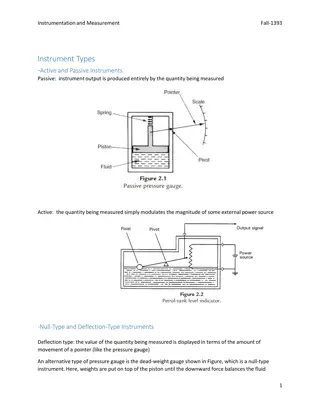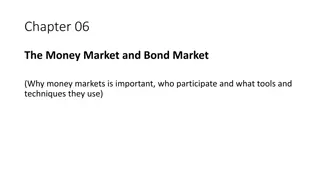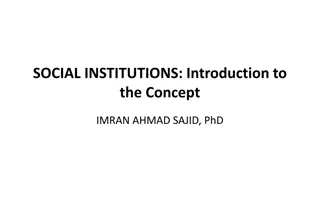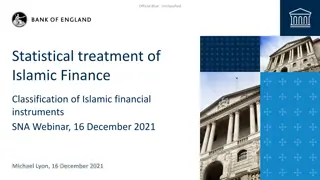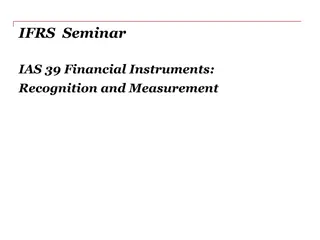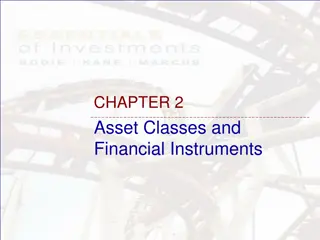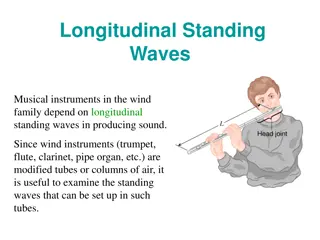Financial Instruments, Markets, and Institutions Overview
Understanding the role of financial instruments, markets, and institutions in the economy is essential. This content covers the flow of funds, primary and secondary markets, bonds, stocks, and various financial instruments. It provides insights into how financial systems function, connecting savers and borrowers efficiently.
Download Presentation

Please find below an Image/Link to download the presentation.
The content on the website is provided AS IS for your information and personal use only. It may not be sold, licensed, or shared on other websites without obtaining consent from the author.If you encounter any issues during the download, it is possible that the publisher has removed the file from their server.
You are allowed to download the files provided on this website for personal or commercial use, subject to the condition that they are used lawfully. All files are the property of their respective owners.
The content on the website is provided AS IS for your information and personal use only. It may not be sold, licensed, or shared on other websites without obtaining consent from the author.
E N D
Presentation Transcript
Chapter 3 1 FINANCIAL INSTRUMENTS, MARKETS, AND INSTITUTIONS
Flow of Funds 2 Financial system provides a transmission mechanism between borrower-spenders. Savers benefit earn interest Investors benefit access to money otherwise not available Economy benefits efficient bringing savers and borrowers together saver-lenders and means of
Flow of Funds (Cont.) 3 Funds flow indirectly from ultimate lenders [households] through financial intermediaries [banks or insurance companies] or directly through financial exchange/bond markets] to ultimate borrowers [business firms, government, or other households] (See Figure 3.1) In order for financial system to function smoothly, must be adequate information about the markets and their operation markets [stock
Figure 3.1 Flow of funds from lenders to borrowers 4
Financial Instruments and Markets 5 Primary Markets Market distributing to saver-lenders. Investment marketing specialists for newly issued securities. Secondary Markets Market where existing exchanged New York Stock Exchange American Stock Exchange for issuing a new security and Banks Information and securities can be
Financial Instruments and Markets (Cont.) 6 Bonds Represent Borrowing Agreement by issuer to pay interest on specified dates and redeem (buy back) the bond upon maturity. Consols Bond with no maturity date, pay interest forever Coupon Securities Attached to bond and sent in to collect interest [generally semi-annually] (A coupon payment on a bond is a periodic interest payment that the bondholder receives during the time between when the bond is issued and when it matures). Zero-coupon Sold at price well below face value. Collect interest when the bond matures (is a bond bought at a price lower than its face value, with the face value repaid at the time of maturity).
Financial Instruments and Markets (Cont.) 7 Stocks Represent Ownership Stockholder owns part of the corporation and receives dividends (a distribution of a portion of a company's earnings, decided by the board of directors) from the issuer. No government stock individuals cannot own part of the government Types of Corporate stocks Preferred Stock Fixed common stock Common Stock Variable company s profits. Convertible Convert preferred into common dividends, priority over dividends, based on
Financial Instruments and Markets (Cont.) 8 Stocks Represent Ownership (Cont.) Existing stock may be exchanged through secondary markets. Capital Gains Difference between price initially paid and amount received when stock is sold. Measures of trends in overall common stock prices Standard & Poor s 500 Stock Index based on prices of 500 individual stocks NASDAQ Composite Index based on all stocks listed in NASDAQ Dow Jones Industrial Average based on price of 30 blue-chip (the largest and most widely held public companies in the United States) stocks
Financial Instruments and Markets (Cont.) 9 Both [securities] represent a claim to a stream of payments [cash flows] in the future Bonds Interest payment and face value at maturity Stocks Dividends and sales price when sold stocks and bonds
Financial Instruments and Markets (Cont.) 10 Options and Futures Contracts Contractual agreement between two parties to exchange a third asset in the future at a stated price Often called derivative because they derive value from underlying assets Long Buyer of the contract, receive commodity in the future Short Seller of the contract, provide commodity in the future Gamble on price fluctuations and hope to profit Eliminate the risk of price fluctuations financial instruments
Financial Instruments and Markets (Cont.) 11 The Capital Market The market for relatively long-term (greater than one year original maturity) financial investment instruments like bonds, stocks. The primal role of this market is to make investment from investors who have surplus funds to the ones who are running a deficit. Stock market Largest part of capital market and held by private and institutional investors Corporate bond market Held by insurance companies, pension and retirement funds Government securities Held by commercial banks, the Fed, individual Americans/foreigners
Financial Instruments and Markets (Cont.) 12 The Money Market Exchange of short-term instruments less than one year Highly liquid Use of a temporary surplus of funds by banks or businesses U.S. Treasury bills short-term government (Issued to meet the short-term needs of the U.S. government) Bank Certificates of Deposits liabilities of issuing bank, interest bearing to corporations that hold them Federal Funds Exchange of excess/deficient reserves between banks on an overnight basis. debts of US
Financial Intermediaries: Purposes and Profile 13 Role of Financial Intermediaries Engage in process of indirect finance Act as agents in transferring funds from savers-lenders to borrowers-spenders. Earn profits on difference between interest paid and earned Diversify portfolios and minimize risk (Risk Sharing e.g. insurance companies) Lower transaction costs (Financial intermediaries make profits by reducing transactions costs by developing expertise and taking advantage of economies of scale) Competition lowers interest rates beneficial to economic growth
Financial Intermediaries: Purposes and Profile (Cont.) 14 Financial Institutions in Profile Commercial Banks Most prominent Range in size from huge (BankAmerica) to small (local banks) Purchase wide variety of assets short-term government securities long-term business loans home mortgages
Financial Intermediaries: Purposes and Profile (Cont.) 15 Commercial banks collect the savings of individuals as well as businesses and then lend those pooled savings to other individuals and businesses. They make money by charging a rate of interest to borrowers that exceeds the rate they pay to savers.
Financial Institutions in Profile Investment Banks Investment banks are specialized financial intermediaries that: help companies and governments raise money provide advisory services to client firms on major transactions such as mergers Firms that provide investment banking services include Bank of America, Goldman Sachs, Morgan Stanley and JP Morgan Chase.
Financial Institutions in Profile Investment Companies Investment companies are financial institutions that pool the savings of individual savers and invest the money in the securities issued by other companies purely for investment purposes.
Financial Institutions in Profile Mutual Funds and Exchange Traded Funds (ETFs) Mutual funds are professionally managed according to a stated investment objective. Individuals can invest in mutual funds by buying shares in the mutual fund at the net asset value (NAV). NAV is calculated daily based on the total value of the fund divided by the number of mutual fund shares outstanding.
Financial Institutions in Profile Mutual Funds and Exchange Traded Funds (ETFs) (cont.) Mutual funds can either be load or no-load funds. The term load refers to the sales commission that you pay when acquiring ownership shares in the fund. These commissions typically range between 4.0 to 6.0%. A mutual fund that does not charge a commission is referred to as a no-load fund.
Financial Institutions in Profile Mutual Funds and Exchange Traded Funds (ETFs) (cont.) An exchange-traded fund (ETF) is similar to a mutual fund except that the ownership shares in the ETF can be bought and sold on the stock exchange. Most ETFs track an index, such as the Dow Jones Industrial Average or the S&P 500, and generally have relatively low expenses.
Financial Institutions in Profile Mutual Funds and Exchange Traded Funds (ETFs) (cont.) Mutual funds and ETFs provide a cost-effective way to diversify and reduce risk. If you had only $10,000 to invest, it would be difficult to diversify since you will have to pay commission for each individual stock. However, by buying a mutual fund that invests in S&P 500,you can indirectly purchase a portfolio that tracks 500 stocks with just one transaction. Alternatively, you might purchase an ETF, such as SPDR S&P 500 (SPY), which tracks S&P 500.
Financial Institutions in Profile (Cont.) Hedge Funds Hedge funds are similar to mutual funds but they tend to take more risk and are generally open only to high net worth investors. Management fees also tends to be higher for hedge funds and most funds include an incentive fee based on the fund s overall performance, which typically runs at 20% of profits.
Financial Intermediaries: Purposes and Profile (Cont.) 23 Financial (Cont.) Life Insurance Companies Insure against death Receive funds in form of premiums Use of funds is based on mortality statistics predict when funds will be needed Invest in long-term securities high yield such as long-term corporate bonds Institutions in Profile
Financial Intermediaries: Purposes and Profile (Cont.) 24 Financial Institutions in Profile (Cont.) Pension and Retirement Funds Concerned with long run Receive funds from working individuals building nest- egg (A substantial sum of money that has been saved or invested for a specific purpose) Accurate prediction of future use of funds Invest mainly in long-term corporate bonds and high- grade stock (A security issued by a leading corporation with a very high rating)
The Basics: How Central Banks Originated and Their Role Today The central bank started out as the government s bank and over the years added various other functions. A modern central bank not only government s finances but provides an array of services to commercial banks. manages the 15-25
The Governments Bank In 1900, only 18 countries had a central bank. The U.S. Federal Reserve began operation in 1914. As the importance of a government and the financial system grew, the need for a central bank grew along with it. 15-26
The Governments Bank As the government s bank, the central bank has a privileged position: It has the monopoly on the issuance of currency. The central bank creates money. Early central banks kept sufficient reserves to redeem their notes in gold. Today, the Fed has the sole legal authority to issue U.S. dollar bills. 15-27
The Governments Bank The central bank can control the availability of money and credit in a country's economy. Most central banks go about this by adjusting short- term interest rates: monetary policy. They use it to stabilize economic growth and information. The primary reason for a country to create its own central bank, then, is to ensure control over its currency. Giving the currency-printing monopoly to someone else could be disastrous. 15-28
The Governments Bank Without a stable currency it is difficult for an economy to run efficiently. This is why preserving the value of a nation s currency is one of the central bank s most important responsibilities. 15-29
The Bankers Bank As the banker s bank, the central bank took on the roles it plays today: To provide loans during times of financial stress, To manage the payments system, and To oversee commercial banks and the financial system. The ability to create money means that the central bank can make loans even when no one else can. 1. 2. 3. 15-30
The Bankers Bank No bank, no matter how well managed, can withstand a run. To stave off such a crisis, the central bank can lend reserves or currency to sounds banks. By ensuring that sound institutions can continue to operate, the central bank makes the whole financial system more stable. banks and financial 15-31
The Bankers Bank Every country needs a secure and efficient payments system. Financial institutions need a cheap and reliable way to transfer funds to one another. The fact that all banks have account at the central bank makes the it the natural place for interbank payments to be settled. In 2009, an average of more than $2.5 trillion per day was transferred over Fedwire. 15-32
The Bankers Bank Finally, someone has to watch over commercial banks and nonbank financial institutions so that savers and investors can be confident these institutions are sound. Those who monitor the financial system must have sensitive information. Government examiners and supervisors are the only ones who can handle such information without conflict of interest. 15-33
The Bankers Bank As the government s bank and the banker s bank, central banks are the biggest, most powerful players in a country s financial and economic system. However, an institution with the power to ensure that the economic and financial systems run smoothly also has the power to create problems. 15-34
The Bankers Bank It is essential that we understand what a central bank is not. It does not control securities markets, though it may monitor and participate in bond and stock markets. It does not control the government s budget. That is determined by Congress and the president through fiscal policy. The Fed only acts as the Treasury s bank. 15-35
Central Bank Objectives: 15-37
